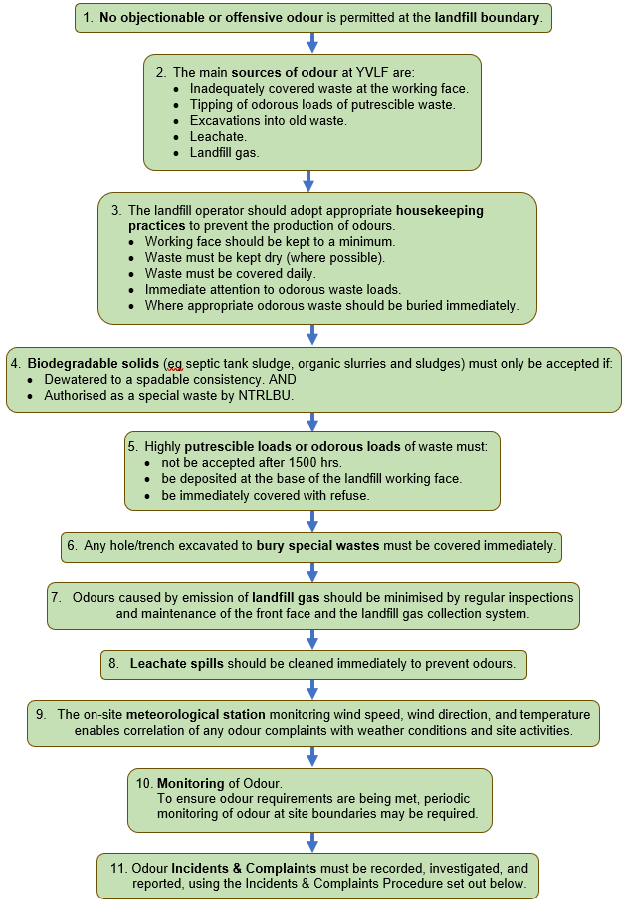Control of Odour
Disclaimer: This procedure guides the operation of YVLF. It is intended as a working document that is improved through operational experience and updated accordingly. Please send updates, changes and comments to landfill@ncc.govt.nz
Flowchart
Procedure
-
The following factors must be taken into account when assessing whether an odour is objectionable or offensive:
Nature.
Frequency.
Intensity.
Duration.
RM975261-F(6) [RM975261V2]
[GS - Additional guidance on what constitutes objectionable or offensive required.]
-
The main sources of odour at a Class 1 Landfill site are:
Inadequately covered waste at the working face.
Tipping of odorous loads of putrescible waste.
Excavations into old waste.
Leachate.
Landfill gas.
[Technical Guidelines for Disposal to Land, WasteMINZ, Revision 3.1, 2023, Chapter 7.10.]
-
The Landfill Operator should adopt appropriate housekeeping practices to prevent the production of odours.
The size of the working face should be kept to a minimum, and the use of daily cover and immediate attention to odorous waste loads will minimise the generation of odours from daily operations. [Technical Guidelines for Disposal to Land, WasteMINZ, Revision 3.1, 2023, Chapter 7.10.]
Odour shall be controlled by keeping refuse dry and covered daily. [LMP 2023 Chapter 4.10.3]
-
Biodegradable solids such as septic tank sludge, organic slurries and sludges will not be accepted at the site unless dewatered to a spadable consistency and specifically authorised as a special waste by the NTRLBU General Manager or appointed representative. [LMP 2023 Chapter 4.10.3]
-
In general excavations into old waste should be kept to a minimum and should be subject to specific controls and operating procedures aimed at controlling odour. [Technical Guidelines for Disposal to Land, WasteMINZ, Revision 3.1, 2023, Chapter 7.10.]
Where a hole/trench has been excavated to bury special wastes, the hole/trench will be covered immediately. [LMP 2023 Chapter 4.10.3]
-
Odour from incoming waste loads should also be minimised by requiring the generators of odorous waste to deliver prior to putrefaction or, if appropriate, to treat the waste to combat odours before delivery. Loads not complying with these requirements should be refused entry and returned for treatment. [Technical Guidelines for Disposal to Land, WasteMINZ, Revision 3.1, 2023, Chapter 7.10.]
-
Odours caused by emission of landfill gas from wells and pipework and from the working face and landfill surface can be significant and should be minimised through regular inspections and maintenance, and timely cover system construction and maintenance. [Technical Guidelines for Disposal to Land, WasteMINZ, Revision 3.1, 2023, Chapter 7.10.]
Odours originating from the generation of landfill gas can be controlled by the development and operation of a landfill gas collection and destruction system. Landfill gas collection system design is addressed in Section 5.8. The landfill gas collection system should be operated in accordance with design objectives. [Technical Guidelines for Disposal to Land, WasteMINZ, Revision 3.1, 2023, Chapter 7.10.]
Damage to the landfill gas collection system by machinery during operations should be repaired immediately to avoid point sources of gas discharge and related odour. [Technical Guidelines for Disposal to Land, WasteMINZ, Revision 3.1, 2023, Chapter 7.10.]
-
Release of volatile organic compounds from leachate is another potential odour source and should be considered in the design of systems for leachate storage, treatment and disposal. [Technical Guidelines for Disposal to Land, WasteMINZ, Revision 3.1, 2023, Chapter 7.10.]
Any leachate on the surface must be removed immediately as it will generate odour as well as contaminate everything it touches.
Leachate should generally be disposed of by burying in the landfill working area.
-
The installation of an on-site meteorological station which monitors wind speed, wind direction, and temperature enables correlation of any odour complaints with weather conditions and site activities. [Technical Guidelines for Disposal to Land, WasteMINZ, Revision 3.1, 2023, Chapter 7.10.]
-
To ensure odour requirements are being met, periodic monitoring of odour at site boundaries may be required.
NTRLBU staff and the Site Operator will:
Monitor the generation and movement of odour on site.
Engage a 3rd party contractor to conduct a monthly audit to measure
A 3rd party contractor carries out an odour and noise site audit each month which include positions around the boundary. This relies on his ears and nose. This is recorded in Survey 123.
-
Reference
-
The Consent Holder shall not accept highly putrescible loads or odorous loads of refuse any later than 1500 hrs. These loads shall be deposited at the base of the landfill working face and immediately covered with refuse.
-
There shall be no odour originating from the Consent Holder's activity discernible within the area cross hatched on the plan annexed hereto which, taking into account its nature, frequency, intensity or duration, is objectionable or offensive.
-
The exposed area of landfill shall be kept to a minimum at all times and refuse placed in the landfill will be compacted using suitable compactor equipment and shall be covered as soon as practicable by clay bound fill materials. Nelson City Council will ensure that there is no wind-blown refuse or objectionable elements from the presence of birds, vermin or smell. Refuse shall not be left uncovered following each day’s closure of the landfill.
Other Discharge Procedures
-
11/24 - Page uploaded from Word document Control of Nuisance - Draft 2.
-
[GS - Additional guidance on what constitutes objectionable or offensive required.]
-
Please send updates, changes and comments to landfill@ncc.govt.nz

